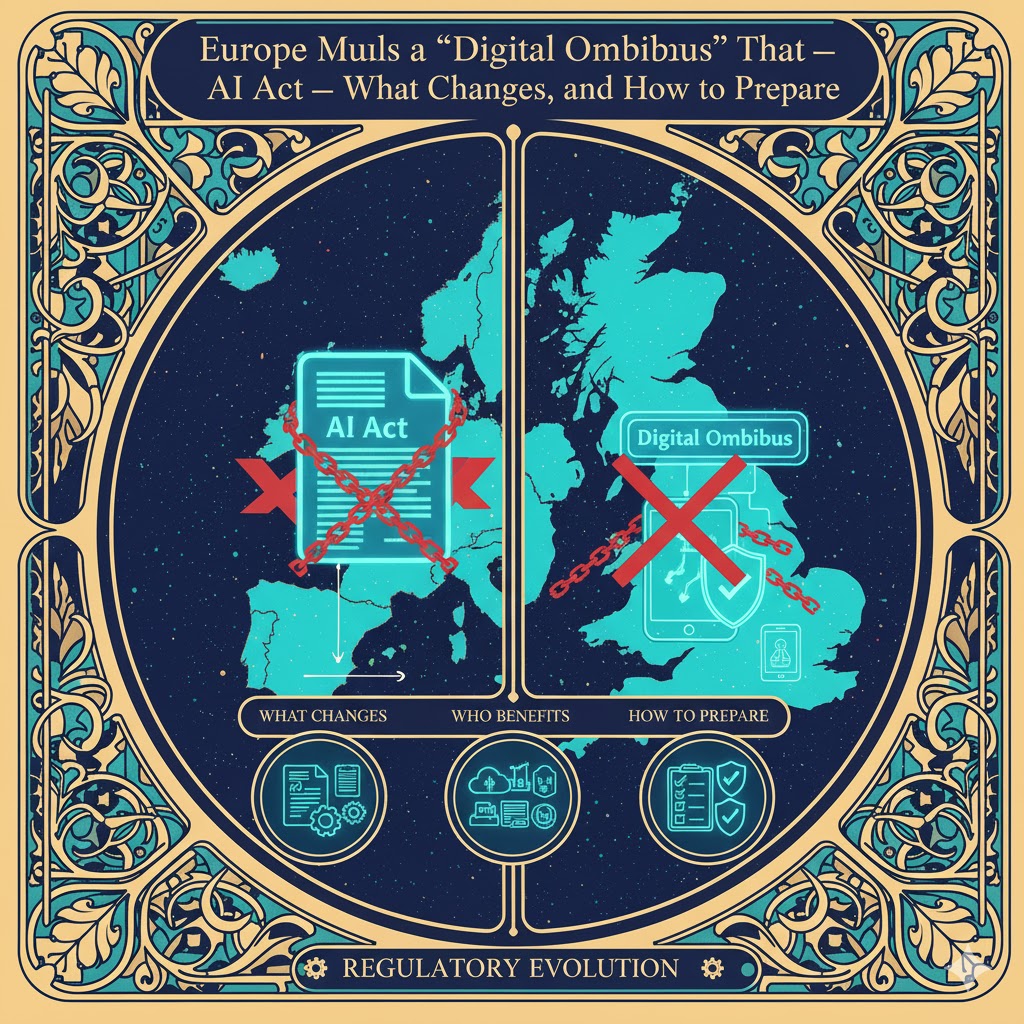TL;DR
A leaked European Commission draft indicates the EU is considering a “simplification” package that would exempt certain limited-function high-risk AI from the EU database registration and delay penalties by ~one year to August 2, 2027. The full proposal is expected November 19, 2025. If adopted, it gives large platforms and enterprises breathing room and reduces near-term enforcement risk—while also increasing uncertainty for startups that invested early in strict compliance. Reuters
What’s on the table
1) Exemptions for limited-function high-risk AI from the EU database
The AI Act requires high-risk systems to undergo ex-ante conformity assessment and be registered in an EU database before market placement. The draft would not require registration when a high-risk system is used only in narrow/procedural roles, easing documentation and administrative load. This narrows the Act’s reach without rewriting its core. Reuters+1
2) A one-year grace period on penalties (to Aug 2, 2027)
Authorities would hold off on fines for some obligations until August 2, 2027, effectively extending the runway for organizations (especially those with GPAI integrations) to retrofit compliance. Several outlets report this timeline; the Commission is expected to present details on Nov 19, 2025. Reuters+1
3) Phased-in transparency/labeling duties
Deepfake and AI-content labeling would phase in more gradually, acknowledging the cost and complexity of watermarking and provenance in production systems. Reuters
Why now? Politics, lobbying, and competitiveness
- Transatlantic pressure & industry lobbying: U.S. officials and Big Tech argued the Act overreaches and risks trade friction; several European CEOs also pushed Brussels to slow down to avoid a competitiveness hit. The Guardian+1
- Regulatory fatigue: The EU is juggling multiple digital regimes (DMA, DSA, Data Act, AI Act). A “Digital Omnibus” to streamline burdens is politically expedient and administratively attractive. Reuters
What’s not changing (so far)
Even if these tweaks land, the architecture of the AI Act remains:
- Risk-based approach: Unacceptable-risk practices are banned; high-risk remains regulated; limited-risk gets lighter transparency rules; GPAI has specific obligations. Artificial Intelligence Act
- Core timelines still matter: The official rollout staggers obligations through 2025–2027; a grace period affects penalties, not necessarily the need to build the capabilities. AI Act Service Desk
Who wins, who loses?
Likely beneficiaries
- Large platforms and multinationals with sprawling AI portfolios get de-risked enforcement and fewer registrations for “procedural” high-risk uses—simplifying Ops, Legal, and PMO overheads. Reuters
- Public-sector deployers wrestling with procurement and legacy systems gain time to align monitoring and incident reporting. (The Commission has been publishing guidance and templates; more will follow.) Digital Strategy
Potentially disadvantaged
- Early-mover startups that invested heavily in database registration prep and strict-by-design processes may see their compliance advantages diluted—while the playing field tilts back toward scale players with stronger lobbying power. Financial Times
Strategic implications for AI leaders
- Plan for two tracks: “law on the books” vs. “law in motion.”
Operate as if the risk-based system remains, but scenario-plan around reduced database scope and delayed penalties. Use the grace period to finish evidence pipelines (data lineage, model cards, post-market monitoring). AI Act Service Desk - Re-classify your high-risk inventory.
Re-evaluate whether some high-risk deployments are truly “limited/procedural” under the draft language. If so, right-size the registration and documentation scope—but do not unwind safety and QA controls you already built. Reuters - Shift resources from paperwork to resilience.
If the database burden eases, redirect capacity toward post-market monitoring, incident reporting readiness, and AI content provenance—areas likely to be enforced and reputationally material. Digital Strategy - Hardening for 2026–2027.
The steepest obligations for high-risk and GPAI consolidate through 2026–2027. Even if fines pause, regulators will expect progress. Build a compliance roadmap that lands controls well before Aug 2, 2027. AI Act Service Desk
A pragmatic readiness checklist
- Map systems to risk tiers (unacceptable / high / limited / minimal / GPAI) and update quarterly through 2026. Artificial Intelligence Act
- For high-risk/GPAI:
- Maintain quality management and data governance artifacts;
- Stand up conformity assessment workstreams (internal or with notified bodies);
- Implement post-market monitoring and serious-incident reporting playbooks. Digital Strategy
- Content provenance: Pilot labeling/watermark options for synthetic media flows (L2 candidates: captions, C2PA manifests, model-side metadata). Reuters
- Program governance: Create a central AI control tower (Legal, Risk, Eng, Product) to track obligations and prepare for spot checks in 2026–2027. AI Act Service Desk
Thorsten’s take: Europe risks falling behind—unless it shifts from paperwork to performance
Softening the AI Act may relieve near-term friction, but it also signals policy indecision. Europe doesn’t need weaker rules; it needs clearer, testable, performance-based guardrails that reward builders who invest in observability, safety evals, and real-world incident learning. If simplification means less administrative theater and more measurable assurance, good. If it simply delays accountability, Europe will keep outsourcing AI leadership—and the economics of AI value-capture—to others. The Guardian+1
Key dates to watch (proposed and official)
- Nov 19, 2025: Commission expected to present the simplification package. Reuters
- Through 2026: Progressive application of high-risk and GPAI obligations under the existing Act. AI Act Service Desk
- Aug 2, 2027: Reported penalty grace end-date in the draft; also aligns with the Act’s full roll-out horizon. Reuters+1
Bottom line
Prepare as if enforcement is coming on time—but use any extra runway to invest in evidence, monitoring, and provenance. That’s where durable advantage (and regulator trust) will come from, regardless of how Brussels tunes the paperwork.
Editor’s note: This analysis draws on a leaked draft and reputable reporting. Details may change when the Commission publishes the official proposal.









